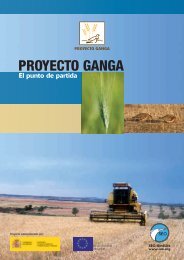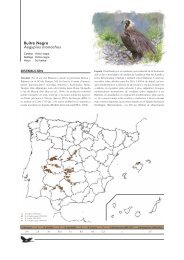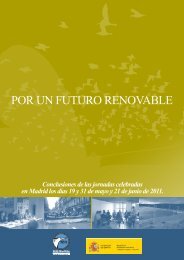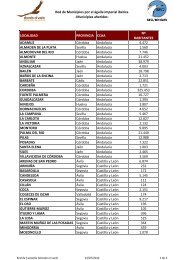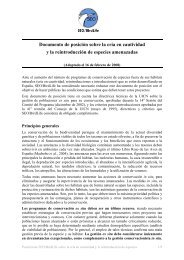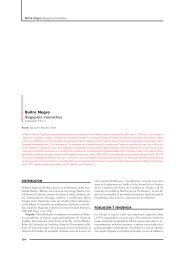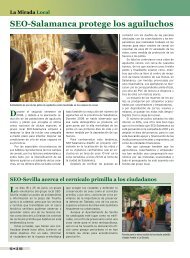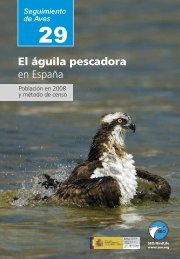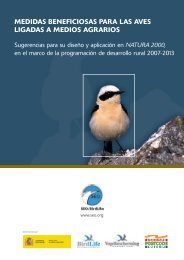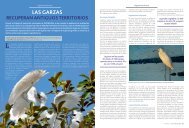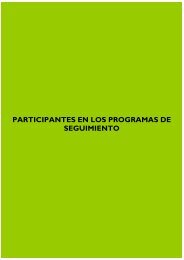El milano real en España. II Censo Nacional (2004) - SEO/BirdLife
El milano real en España. II Censo Nacional (2004) - SEO/BirdLife
El milano real en España. II Censo Nacional (2004) - SEO/BirdLife
You also want an ePaper? Increase the reach of your titles
YUMPU automatically turns print PDFs into web optimized ePapers that Google loves.
Summary<br />
where the population remains stable, and for Catalonia, where a population increase<br />
has occurred (figure 3).<br />
The breeding red kite c<strong>en</strong>sus for the Basque Country shows that the population<br />
has decreased by 50% in Álava province. In 1994, betwe<strong>en</strong> 0 and 10 pairs were<br />
estimated for Galicia and the northern Spanish coast, and the c<strong>en</strong>sus for La Rioja<br />
yielded no results. The breeding population remains stable in Navarra with<br />
263 pairs, although changes in the distribution range have be<strong>en</strong> id<strong>en</strong>tified.<br />
Aragón had 386-527 pairs in 1994, decreasing to 258-363 in <strong>2004</strong>. Despite this<br />
overall picture, the situation within provinces is very differ<strong>en</strong>t. Huesca province<br />
used to host almost 80% of the breeding pairs in Aragón, but the population has<br />
undergone a decline from 305-441 pairs in the 1994 c<strong>en</strong>sus to 169-245 pairs in<br />
the <strong>2004</strong> counts. Moreover, the 5-10 pairs estimated for Teruel province in 1994<br />
may have disappeared completely from this area. On the contrary, the breeding<br />
numbers seem to have increased slightly in Zaragoza, where curr<strong>en</strong>t records are<br />
89-118 pairs.<br />
The number of breeding pairs in Catalonia has doubled since the 1994 c<strong>en</strong>sus,<br />
unlike the overall tr<strong>en</strong>d dominating elsewhere in Spain.<br />
Castilla y León hosted 50% of the total breeding pairs in Spain in 1994. Subsequ<strong>en</strong>t<br />
c<strong>en</strong>suses show a decrease for the region betwe<strong>en</strong> 36.6% and 43%, with<br />
differ<strong>en</strong>t tr<strong>en</strong>ds for the various provinces.The breeding numbers remain stable in<br />
Pal<strong>en</strong>cia and León, both with populations of a similar size.The population in Valladolid<br />
has increased from 33-34 to 41 pairs, and the population in Soria has<br />
doubled to reach a curr<strong>en</strong>t record of 97 pairs. In Burgos, the number of pairs has<br />
gone down from 30-50 to 23, and the same tr<strong>en</strong>d occurred in the three main<br />
breeding provinces. In Zamora, an average decrease of 45.6% has be<strong>en</strong> estimated<br />
for the period 1994-<strong>2004</strong>, and Salamanca has lost more than half of its breeding<br />
population. Segovia was, in 1994, the province having the largest pair d<strong>en</strong>sity<br />
average, similar to the average for c<strong>en</strong>tral European countries (Viñuela et al.,<br />
1999); a decade on, the decrease could be up to 70-80% for this province.<br />
The negative tr<strong>en</strong>d for the species in Spain is also reflected in Castilla-La Mancha,<br />
with records for 20-23 pairs in <strong>2004</strong>. Of these, 16 pairs are recorded in Toledo,<br />
which had 30-37 pairs in 1994. Only 3 pairs, 2 of them in the Parque <strong>Nacional</strong><br />
de Cabañeros, seem to remain in Ciudad Real from the 15-20 pairs estimated t<strong>en</strong><br />
years ago. Cu<strong>en</strong>ca province maintains a population of 1-4 pairs located in the<br />
surroundings of Cu<strong>en</strong>ca city and the Cabrejas mountain pass. As in 1994, no<br />
127



